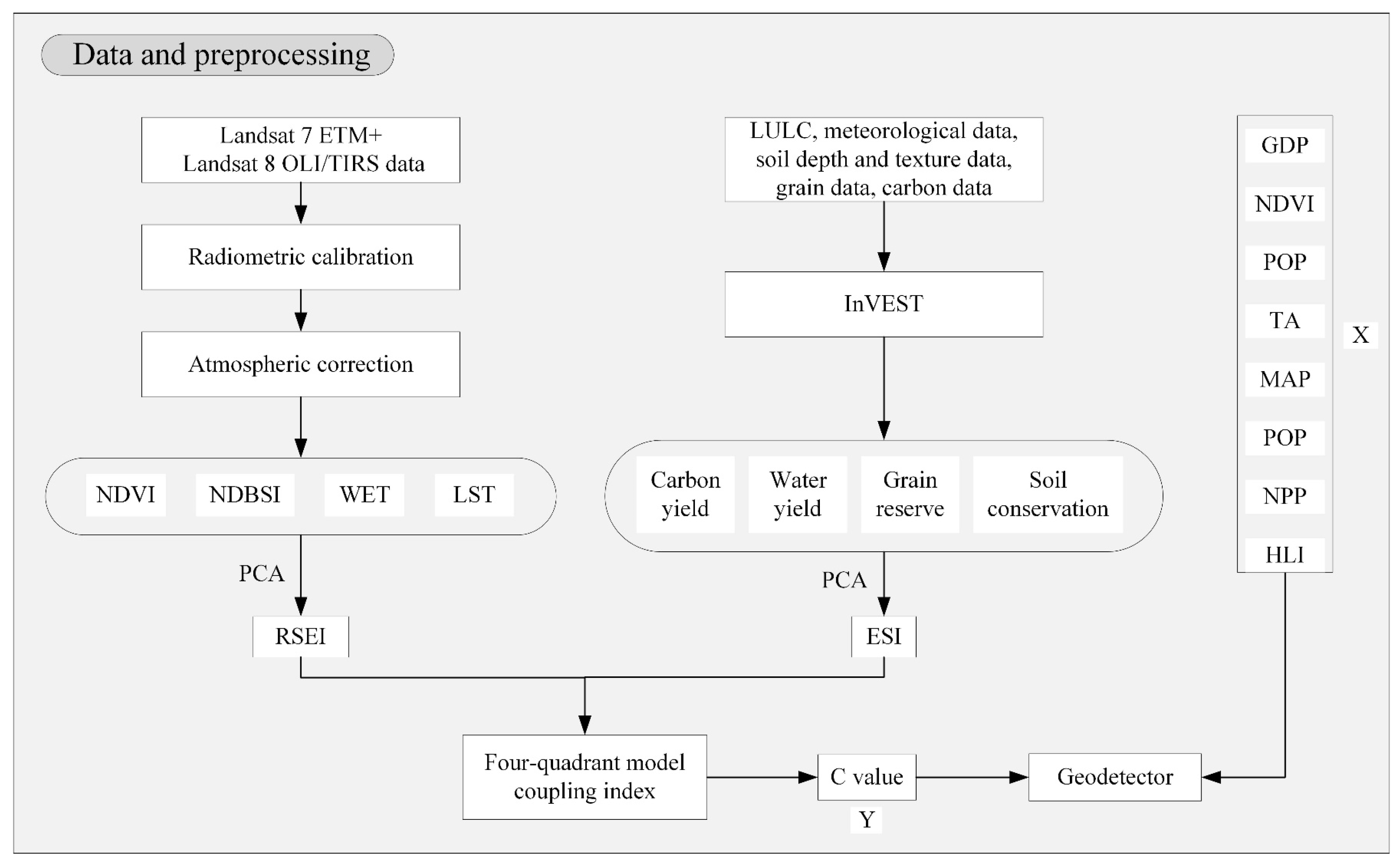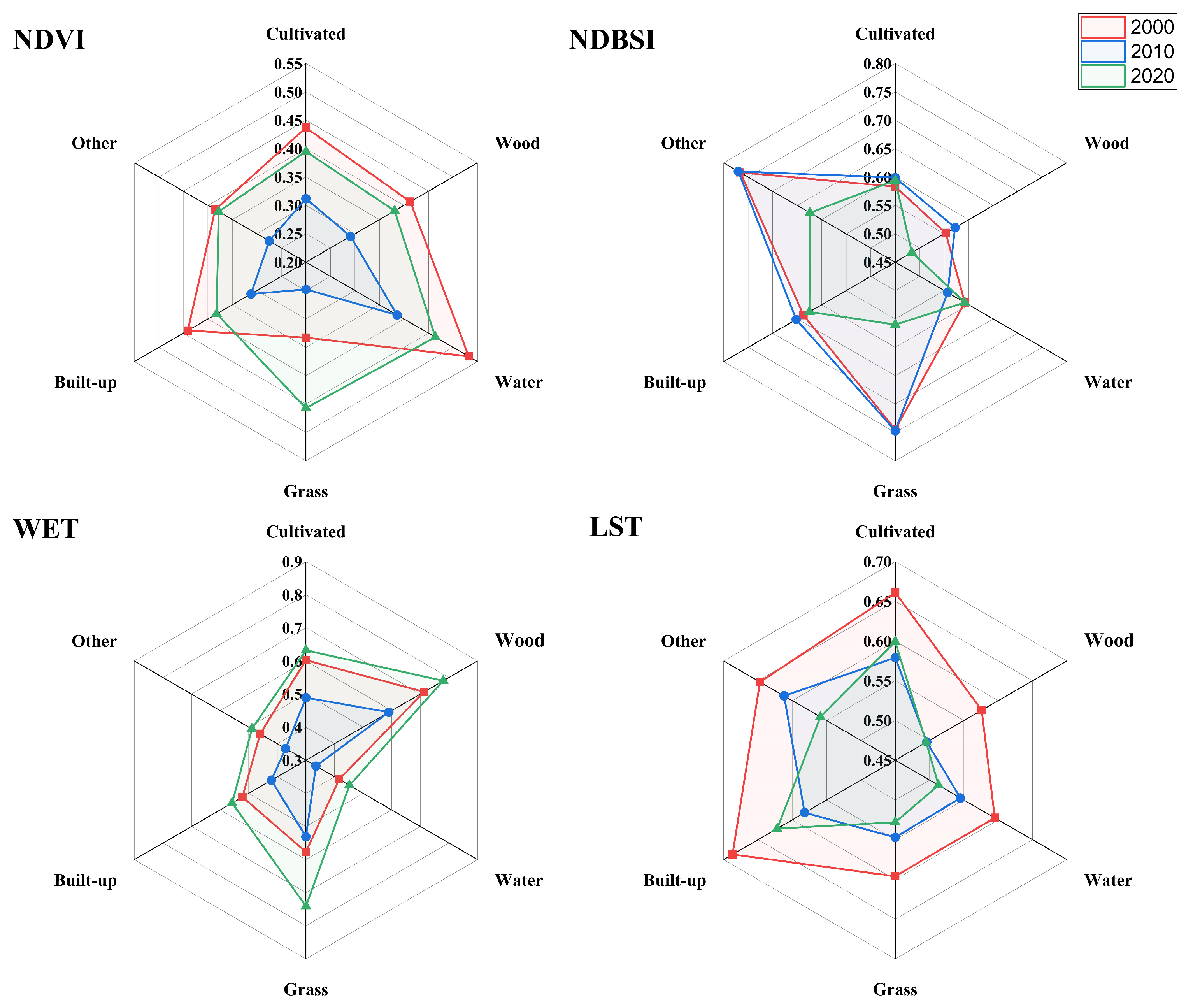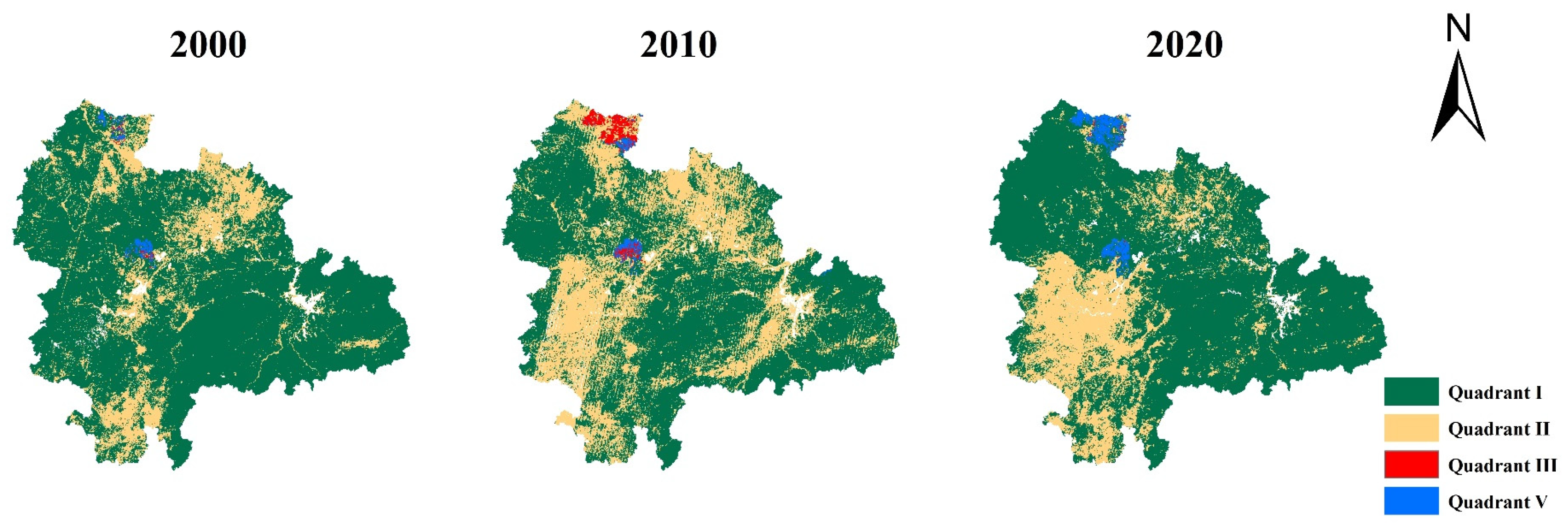1. Introduction
The rapid advancement of industrialization and urban expansion has exerted unprecedented pressure on ecosystems, leading to widespread degradation. Intensive deforestation, uncontrolled urban sprawl, environmental pollution, and excessive waste discharge have significantly altered land use patterns, resulting in substantial ecosystem deterioration that critically undermines ecological stability and ecological service functions [
1,
2]. This trend is highly consistent with the focus areas of international frameworks, such as the
Kyoto Protocol and the
Transforming our World: The 2030 Agenda for Sustainable Development. The
Kyoto Protocol is a legally binding international treaty on commitments to greenhouse gas reduction to mitigate global warming [
3,
4].
Transforming our World: The 2030 Agenda for Sustainable Development is a global blueprint for achieving sustainable development goals. These international frameworks aim to consolidate global efforts aimed at addressing ecological crises and advancing sustainable development worldwide [
5,
6]. In this context, the UAMRYR, as a key component of China’s ecological security framework, is facing two threats from urbanization and climate change to its wetlands, forests, and other ecosystems [
7,
8]. To address these challenges, this study employed an RSEI and an ESI to construct a quantitative assessment system, combined with Geodetector’s analytical driving mechanism, aiming to provide precise decision support for regional sustainable development [
9].
Remote sensing technology, due to its advantages, such as its wide coverage, high resolution, and real-time monitoring, provides important technical support for regional ecological environment assessments [
10,
11,
12,
13]. Indicators like the NDVI [
14,
15], the Normalized Difference Bare Soil Index (NDBSI) [
16], Land Surface Temperature (LST) [
17], and WET enable long-term ecological monitoring of vegetation changes, temperature fluctuations, and land transformations, offering effective technical solutions for vegetation tracking, climate change evaluation, and urbanization studies [
18]. However, due to the complexity and diversity of ecosystems, single ecological indices cannot fully capture environmental quality [
19]. Therefore, by systematically integrating the four key ecological indicators, namely the NDVI, WET, LST, and NDBSI, and based on principal component analysis (PCA), a comprehensive RSEI was constructed. This index effectively overcomes the limitations of a single ecological indicator and enables a comprehensive quantitative assessment of the regional ecological environment quality [
20,
21,
22]. The RSEI can not only accurately reflect the temporal and spatial evolution characteristics of an ecosystem, but it can also precisely identify the hotspots of ecological degradation. This provides an important spatial decision-making basis for formulating targeted ecological protection and restoration measures [
23,
24,
25].
An ecosystem service assessment quantifies the correlation between ecological functions and human well-being, providing key technical support for the quantitative assessment of ecosystem health and the identification of potential degradation risks [
26,
27,
28,
29]. As an important basis for regional sustainable development decisions, the four core indicators, namely carbon storage capacity (reflecting the climate regulation function), water yield (indicating the potential for water resource supply), soil retention capacity (measuring the efficacy of soil erosion prevention and control), and food supply (representing the level of biological productivity), have formed the benchmark framework for ecosystem service evaluations [
30,
31,
32]. However, traditional assessment methods (such as physical measurement methods and market value methods) have obvious limitations: They are unable to comprehensively quantify the multi-dimensional service value of ecosystems, and fail to fully reflect the interactive influence of human activities and ecological processes [
33]. The proposed ESI is specifically designed to address these shortcomings. It integrates the biological and physical data provided by methods such as the Integrated Valuation of Ecosystem Services and Tradeoffs (InVEST) model and remote sensing, thereby reducing the reliance on socio-economic indicators and directly capturing often overlooked ecosystem features, such as landscape connectivity and ecological restoration capabilities [
33]. Therefore, by using four key ecological indicators, namely carbon storage capacity, water yield, soil retention capacity, and food supply, and based on PCA, the ESI was constructed. This model–data hybrid approach enhances the objectivity of ecosystem assessments by reducing the anthropogenic interference in parameter weighting processes, while preserving the intrinsic relationships between ecosystem structures and functions. The ESI provides a quantifiable spatial decision-making tool for optimizing ecological compensation policies and delineating ecological protection red lines, which is conducive to the coordinated advancement of ecological protection and sustainable development [
30,
31,
32].
Although the RSEI and ESI provide independent assessment frameworks from the perspective of ecological environment quality itself and ecosystem service functions, respectively, they have natural complementarity in terms of representing the co-evolution of the human–environment relationship. By coupling the ecological state monitoring capability of the RSEI with the service value quantification function of the ESI, a ‘state–service’ dual-dimensional evaluation system can be constructed, breaking through the limitations of single perspective assessments [
34,
35]. To deepen this coupled evaluation framework, this study introduced a four-quadrant spatial zoning model [
36,
37]. Based on the thresholds of the RSEI and ESI, the study area was divided into four characteristic types of zones: high RSEI–high ESI (high-quality synergy zone), high RSEI–low ESI (potential transformation zone), low RSEI–high ESI (pressure-bearing zone), and low RSEI–low ESI (degradation and restoration zone). To deeply explore the mechanism of the impact of human activities on the ecosystem, this study proposes the use of the coupling coefficient C to quantify the degree of synergy between the RSEI and ESI in regard to different land use types and spatial divisions. This study innovatively introduced the geographical detector method [
38], deeply analyzing the spatial differentiation characteristics and driving mechanisms of the coupling coefficient C value between the RSEI and ESI, quantitatively evaluating the independent contribution of each environmental factor to the spatial distribution of the C value, and accurately identifying the key driving factors affecting the “state–service” synergy relationship of the ecosystem. Through the use of factor interaction detection, the collaborative influence mechanism of natural elements and human activities on the C value was revealed, which has significant methodological innovation value [
39].
Addressing these research gaps, this study utilizes multi-source remote sensing data to analyze the spatiotemporal changes and driving forces of the ecological benefits in the UAMRYR, establishing scientific foundations for refined territorial spatial governance. The research framework comprises three components: (1) an evaluation of the spatiotemporal variations in land use types, the RSEI, and the ESI within the study area, from 2000 to 2020; (2) the use of a coupled model to quantitatively analyze the collaborative evolution relationship between the RSEI and the ESI from 2000 to 2020, and the use of statistical correlation tests to conduct an objective assessment; and (3) the identification of key drivers influencing the RSEI–ESI coupling dynamics and the analysis of their driving mechanisms and interaction effects.
4. Discussion
4.1. RSEI Variation Analysis
A comprehensive analysis of
Figure 3 and
Figure 6 reveals that the evolution of the LULC in relation to the RSEI values in the UAMRYR region from 2000 to 2020 exhibited significant synergistic characteristics. Areas with high RSEI values were concentrated in the wetlands of Dongting Lake, the Mufu Mountain forest belt, and the water body protection zones along the mainstream of the Yangtze River. The increase in forest land and water body coverage in these areas underscored the supportive role of the natural ecological foundation in maintaining ecosystem quality. Areas with low RSEI values were primarily located in the Wuhan Metropolitan Area, where the expansion of built-up land significantly overlapped. The changes in cultivated land demonstrated a dual regulatory pattern: the intensification of farmland in the Jianghan Plain through water-saving irrigation slightly increased the RSEI, while the fragmentation or abandonment of cultivated land in suburban areas led to a decline in the RSEI. The spatial expansion of the region followed a pattern of “expanding eastward into the Jianghan Plain and westward into the hilly and mountainous areas.” The spread of built-up land in the Wuhan and Changsha–Zhuzhou–Xiangtan urban agglomerations encroached upon the ecological spaces of traditional agricultural areas in the central region.
Ecological restoration projects have achieved remarkable results, yet significant regional disparities exist: The project of converting farmland back to lakes in the Dongting Lake area and the project of converting farmland to forests in the mountainous regions of western Hubei have, respectively, enhanced the RSEI values by restoring water bodies and forest lands. The Wuhan Green Core Project has focused on restoring fragmented urban habitats through ecological corridors. However, the resurgence of land reclamation around Poyang Lake has led to a decrease in grassland areas and a decline in the RSEI values, indicating that ecological restoration efforts require long-term policy guarantees.
4.2. ESI Variation Analysis
Figure 9 and
Figure 11 illustrate that there is a pronounced gradient in carbon sequestration, soil conservation, and water yield services, following the order of forestland > cropland > built-up land. In contrast, the trend for grain production services exhibits an inverse pattern, namely built-up land > cropland > forestland. These findings are consistent with the ecological functional characteristics of land use: Forestland, due to its high vegetation cover and deep soil structure, plays a dominant role in carbon sequestration and soil and water conservation functions. Although cropland is more efficient in regard to grain production, its ecological regulatory capacity is weaker than that of forestland. Built-up land, with its increased surface impermeability, significantly enhances water yield service capabilities, but contributes less to grain production.
The PCA further unveils the trade-off relationships among regulatory services across various land use types, such as the heterogeneity in hydrological regulation between water bodies and grasslands, as well as the intensifying impact of built-up land expansion on water availability. PCA is used to construct a comprehensive ESI by extracting principal components from multiple indicators, thereby circumventing subjective weight assignments, and objectively reflecting the spatial differentiation characteristics of ecosystem services within the study area, thus offering robust data support for ecological assessments.
4.3. Coupling Relationship and Coupling Level Analysis Between RSEI and ESI
During the process of ecological and environmental changes in the UAMRYR region, the C value between the RSEI and the ESI exhibits distinct spatial–temporal differentiation characteristics, effectively reflecting the synergistic relationship between the RSEI and the ESI amidst changes in ecological and environmental quality. An analysis combined with LULC changes reveals that the process of built-up land encroaching upon the ecological space of cropland often leads to a rapid decline in the RSEI, while the ESI tends to decrease more slowly due to its inherent lag effect. In areas significantly affected by human engineering activities, such as regions undergoing rapid urban expansion and industrial development, both the RSEI and the ESI tend to decline concurrently. Issues such as the destruction of natural vegetation and soil pollution during the urbanization process have led to a dual impairment of both ecological and environmental quality and ecosystem service functions. Consequently, the NDVI in these areas has decreased significantly, reflecting the dual pressures exerted by human activities on the ecological environment.
It is recommended to establish a synergistic monitoring framework for the RSEI–ESI, prioritizing the construction of ecological corridors in areas undergoing built-up land expansion to interrupt the cascading effect of “RSEI decline–ESI lagging deterioration,” and to implement conservation tillage practices in major agricultural production areas to mitigate the “hidden depletion” of the ESI, thereby supporting the optimization of territorial spatial resilience.
4.4. Spatial Autocorrelation and Driver Analysis
The spatial differentiation pattern in the UAMRYR region is predominantly driven by the dynamic intensification of the synergistic effects among multiple interacting factors. The coupling effects between economic and natural factors unveil the profound contradictions inherent in regional development: The interaction intensity between GDP and MAP has surged dramatically, indicating an intensified reliance of economic growth on climatic resources, which may amplify the potential risks associated with uneven regional water resource distribution. The interaction intensity between the NLI and TA has also skyrocketed, suggesting that the combined effects of urban heat island phenomena and global warming may reshape local microclimates, exacerbating thermal stress on ecosystems. The interactive characteristics between ecological and social factors further underscore the extreme pressures exerted by human activities on ecosystems: The interaction intensity between the POP and NPP was notably high in 2010, reflecting the dynamic compression of the ecological carrying capacity due to population aggregation amidst rapid urbanization. In 2020, the interaction intensity between the NDVI and TA approached 1, serving as a warning that the intensity of economic development has moved toward the critical threshold in terms of ecologically sensitive areas, potentially triggering irreversible ecological degradation. The spatiotemporal evolution of these interactive effects suggests that the maintenance of regional ecological security patterns necessitates transcending the limitations of single-factor regulation, with a primary focus on the dynamic feedback mechanisms subject to the synergistic effects of multiple factors.
The interaction analysis reveals that the nonlinear synergistic effects between economic and natural factors significantly exacerbate spatial heterogeneity. The coupling effects between economic growth and climatic resources have notably amplified regional disparities over time, emerging as the core driving force behind the differentiation of ecological patterns. Meanwhile, the combined effects of urban heat island phenomena and global warming have accelerated the restructuring of ecological patterns in sensitive areas. Simultaneously, the interactive pressures between human activities and the ecological carrying capacity are particularly pronounced in regions undergoing high-intensity development, highlighting the profound disruptions caused by socioeconomic factors to the stability of ecosystems.
6. Limitations and Future Scope
This study employed the Geodetector model to analyze the spatial heterogeneity impact of natural and socio-economic factors on the coupling relationship between the RSEI and the ESI. By breaking through the linear assumption limitations of traditional regression models, it revealed the cascading driving mechanism of multi-factor interactions, providing a spatially explicit diagnostic tool for identifying the “threshold mutation” risks in ecologically sensitive areas. However, this study has the following limitations: The type of analysis, which is based on medium-resolution remote sensing data, means that it is difficult to capture the responses of micro-ecological processes, which may weaken the representation of the spatial heterogeneity of local ecological feedback. The spatial refinement representation of social driving factors is still insufficient, which may underestimate the potential impact of human factors on ecological regulation. Although the 20-year research period can reflect the recent ecological evolution characteristics, it is not sufficient to capture longer-term climate change trends.
Future research can introduce a multi-source heterogeneous technology integration scheme, for instance, using unmanned aerial vehicle (UAV)-mounted hyperspectral imaging to achieve sub-meter level ecological parameter inversion, combining LiDAR point cloud data to extract three-dimensional vegetation structural features, obtaining real-time environmental gradient data through an Internet of Things sensor network, and integrating multi-temporal remote sensing data and socio-economic big data using deep learning frameworks, thereby constructing an integrated ‘air–ground–network’ monitoring system. This technological combination not only enhances the spatiotemporal continuity of ecological process simulation through multimodal data fusion, but also enables the intelligent completion of missing data areas through the use of algorithms, such as Generative Adversarial Networks (GAN), providing more precise scale support for revealing the patterns of ecological threshold mutations.






















